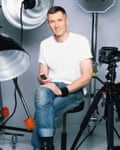I was a classical concert harpist before I became a photographer. I studied at the Paris conservatoire and signed with EMI Classics. Then, in 1994, aged 33, a hand injury prevented me from playing. I made a quick decision to do something else and that’s how I became a photographer – despite the fact I had never owned a camera. I had read a book about photography but that was it. I sold all my harps and spent $100,000 on photo equipment before ever taking a picture. I locked myself in my apartment, got a store mannequin and just started practising with the same intensity I had done with the harp.
In the beginning, because I had been a musician, I wasn’t interested in shooting musicians. I only wanted to shoot sexy models. My dream was to shoot for Playboy. But just a few years later, it was the music industry that reached out to me. I didn’t want to do it but my agent was screaming at me to, saying: “You’re crazy!”
I shot Beyoncé for the first time in 2000 for Vibe magazine, when she was part of Destiny’s Child. I knew she was a superstar right away. She walked in and I said to her mother, Tina, who was styling the shoot: “This one in the middle here, she’s going to be a huge star.” Tina looked at me like: “Yeah, we know.” After that, things really started taking off with music shoots.
In 2003, Beyoncé asked me to shoot the cover of her debut solo album, Dangerously in Love. She mentioned a campaign I’d done showing Laetitia Casta lying on a diamond-studded spider’s web. Beyoncé wanted something similar, but smaller. When they arrived for the shoot – and again her mother was styling her – I pointed at the diamond top as they brought out all the outfits and said: “That’s exactly what we discussed.”
But Beyoncé was reluctant because her mother had only brought skirts to pair it with, and she felt it would make the look too red carpet. I suggested she pair it with jeans. She liked that idea but they hadn’t brought any. So I gave her mine – on that famous, iconic cover, she is wearing my jeans! People ask if that meant I wasn’t wearing any trousers while shooting her, but I was – I had another pair, luckily. A few months later, she returned the jeans. She’d had them cleaned and they were nicely wrapped with a ribbon.
In 2003, Beyoncé was not the Beyoncé she is now. She was still a young girl from a group. While she was well-known, she wasn’t the biggest pop star in the world. She was friendly and professional on set. She is a hard worker and an intuitive and intelligent model. She knows what to do. The pose on the cover just happened – it was not me directing her. She just snapped into it and I knew immediately that this was the shot.
after newsletter promotion
The final image was totally the vision I had for her: this sexy, glossy look that I felt represented her best. I didn’t want to do anything low-key or lo-fi with daylight. But that top did not look exactly how it does on the cover: there was a lot of post-production and manipulation. It was much more flimsy than it appears and it wasn’t staying strategically in place – she’s not wearing anything other than those strings of diamonds, so she was pretty much topless on set. Later, in post-production, everything was perfected and arranged to make sure nothing shows.
There’s a magic on set that either happens or it doesn’t. I think it has a lot to do with the connection between the subject and the photographer. It’s not about being best friends: it’s about an energy that has to be there. With Beyoncé, that energy seemed to naturally happen.
For me, this image projected who Beyoncé was about to become. She wasn’t quite the person that the photos represented, but within a couple of years she had become that iconic, undeniable superstar. The photoshoot created a road map to where she was headed.
Markus Klinko’s CV
Born: Winterthur, Switzerland, 1961
Trained: Self-taught
Influences: “Andy Warhol is my role model for career management and business strategy. I also love Helmut Newton.”
High point: “Now! I’ve had a lot of success with my exhibitions. I have 10 this year.”
Low point: “The financial crash in 2007-8 prompted major budget cuts and suddenly I was considered way too expensive. I didn’t react quickly enough and it allowed the social media photographers to take over the advertising jobs.”
Top tip: “Don’t be impatient. It’s going to be tough: the competition is fierce and you’ll have to prove yourself again and again. But don’t get discouraged.”

